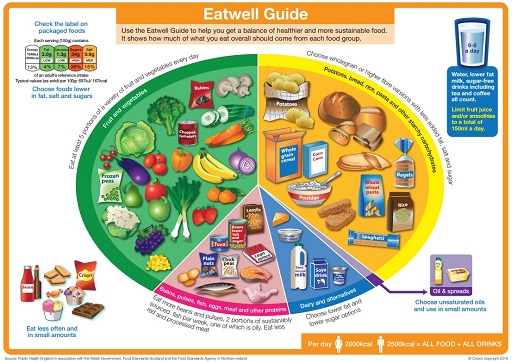1 The components of a balanced diet
A balanced diet contains six key nutrient groups that are required in appropriate amounts for health. These groups are outlined below.
Proteins are involved in growth, repair and general maintenance of the body.
Carbohydrates are usually the main energy source for the body.
Lipids or fats are a rich source of energy, key components of cell membranes and signalling molecules, and as myelin they insulate neurons (nerve cells).
Vitamins are important in a range of biochemical reactions.
Minerals are important in maintaining ionic balances and many biochemical reactions.
Water is crucial to life. Metabolic reactions occur in an aqueous environment and water acts as a solvent for other molecules to dissolve in.
A deficiency of any one type of nutrient can lead to disease, starvation (or dehydration in the case of water) and subsequent death. Fibre is a component of food that is not nutritious but is important to include in our diet. Fibre or roughage is non-digestible carbohydrate and it has an important role in aiding the movement of food through the gut.
There is also an absolute requirement for some specific molecules in the diet. This is because, although the body can manufacture most of the molecules it needs, some essential molecules cannot be made by the body. These molecules are called essential nutrients, and must be supplied in the diet, for example lysine and methionine, which are essential amino acids.
Other components of the human diet are not nutrients at all, as they do not perform the functions of producing energy or promoting growth and repair, but are eaten for other purposes. For example, spices and other flavourings help make food more palatable; tea and coffee drinks provide a good source of water and may also contain other valuable substances such as antioxidants (see below).
An adequate diet is essential for health and education plays a key role in providing people with the knowledge of what constitutes a healthy diet, but as is so often the way with science, the information keeps changing. The information about what we should be eating comes from various sources: in the UK a large amount of data was collected and published by COMA, the Committee on Medical Aspects of Food Policy (1991). This committee has now been disbanded, but its publications still represent a valid source of information about diet. When this course was published (2004), the Scientific Advisory Committee on Nutrition (SACN) advised the Department of Health and the Food Standards Agency (FSA), and the Food Standards Agency produced a guide to choosing a healthy diet, ‘The balance of good health’. Currently (2020) Public Health England produces the Eatwell Guide to visually communicate government recommendations for a healthy diet. This is shown in Figure 1. A lack of an adequate supply of any nutrient is known as malnutrition and leads to poor health.
Activity 1
Does Figure 1 enable you to identify any nutrient that might be inadequately represented in your diet?
Answer
Figure 1 is a representation known as a pie chart. It enables you to see the relative proportions of each of the food categories that are likely to make up your diet. It is a fairly crude instrument and does not allow you to identify any nutrient deficiency.
Figure 1 can be useful tool for teaching children about a healthy diet.
Activity 2
How much fruit and vegetables should you eat?
Answer
Fruit and vegetables should make up over a quarter of your daily intake.
The message in Figure 1 is simple and it emphasizes balance rather than focusing on specific nutrients.
However, SACN does recommend a range of intake levels for all nutrients and energy for males and females throughout life, known as the dietary reference values (DRVs). Because individuals vary in their exact energy requirements, depending on sex, age, occupation and many other factors, often the estimated average requirement (EAR) is given, with the understanding that some individuals need more than this value and others less. EAR values for energy are shown in Table 1.
| Age | EAR/kcal per day | |
|---|---|---|
| Males | Females | |
| 0–3 months | 545 | 515 |
| 4–6 months | 690 | 645 |
| 7–9 months | 825 | 765 |
| 10–12 months | 920 | 865 |
| 1–3 years | 1230 | 1165 |
| 4–6 years | 1715 | 1545 |
| 7–10 years | 1970 | 1740 |
| 11–14 years | 2220 | 1845 |
| 15–18 years | 2755 | 2110 |
| 19–50 years | 2550 | 1940 |
| 51–59 years | 2550 | 1900 |
| 60–64 years | 2380 | 1900 |
| 65–74 years | 2330 | 1900 |
| over 75 years | 2100 | 1810 |
| pregnancy | + 200* | |
| lactation | + 450–80 | |
*During the last three months of pregnancy.
Activity 3
From Table 1, identify the age at which males require the most dietary energy. Suggest why this may be so.
Answer
The highest energy intake, 2755 kcal per day, is required between the ages of 15 and 18. This is the age range in which boys grow and increase their muscle mass to achieve their adult size and shape. They are also maturing sexually at this stage.
Dietary reference values in fact comprise three numbers: the EAR, just discussed, the reference nutrient intake, RNI, and the lower reference nutrient intake, LRNI. These figures replace the old recommended daily amount (RDA), which was felt not to offer sufficient flexibility for individuals’ differing needs. The RNI is set at a level that satisfies the requirements of 97.5% of the population, and the LRNI is set at a level that satisfies the needs of only 2.5% of the population. Thus almost everyone has requirements falling between these two figures. You may have noticed that over the last few years the information on food packaging has shifted emphasis from a categorical ‘satisfies 20% of RDA’, for example, and more towards a list of ingredients, perhaps with an exhortation to ‘eat five portions of fruit each day’. This reflects the move away from a ‘one-size-fits-all’ RDA to a situation in which individuals’ needs can be accommodated.
Individual requirements for nutrients vary considerably depending on factors such as age and sex as you saw above. Other relevant factors are size, metabolic rate (see below) and occupation. The situation is further complicated as interactions between components of the diet may alter the efficiency of absorption or utilization of a particular nutrient. The body also has stores of certain nutrients (fat-soluble vitamins, for example) so that variations in daily intake of such nutrients can be accommodated. Thus it could be misleading to recommend a particular daily intake level.
In summary:
A balanced diet consists of six main nutrient groups; proteins, carbohydrates, lipids, vitamins, minerals and water.
Dietary reference values (DRVs) comprise a range and an estimated average of recommended daily intake levels for nutrients and energy for males and females at different stages of their life.

